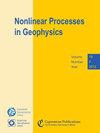High-frequency Internal Waves, High-mode Nonlinear Waves and K-H Billows on the South China Sea's Shelf Revealed by Marine Seismic Observation
IF 1.7
4区 地球科学
Q3 GEOSCIENCES, MULTIDISCIPLINARY
引用次数: 0
Abstract
Abstract. From July to September 2009, a set of multi-channel seismic data was collected in the northern shelf area of the South China Sea. After the data was processed, we observed a series of shoaling events on one of the survey lines, including high-frequency internal waves, high-mode nonlinear internal waves, and shear instability. Using theoretical results from previous numerical simulations and field observations, coupled with local temperature and salinity data, we analyzed their depth distribution, waveform characteristics, and formation mechanisms, and discussed the influence of seafloor topography and stratification on the shoaling of solitary internal waves. We estimated the mixing parameters of seawater using a parameterization scheme based on hydrographic data and seismic data, respectively. And we found that the diapycnal mixing caused by these shoaling events in the shelf area were about 3.5 times greater than those on the slope. Consequently, the fission of internal solitary waves and the induced shear instability serve as significant mechanisms for the energy dissipation of internal solitary waves at the slope and shelf of the South China Sea. Additionally, the high-frequency internal waves generated during shoaling might also have a crucial role in this process.海洋地震观测揭示的南海大陆架高频内波、高模非线性波和 K-H 波浪
摘要2009 年 7 月至 9 月,我们在南海北部大陆架地区采集了一组多道地震数据。数据处理后,我们在其中一条测线上观测到了一系列浅滩事件,包括高频内波、高模非线性内波和剪切不稳定性。利用以往数值模拟和现场观测的理论结果,结合当地的温度和盐度数据,我们分析了它们的深度分布、波形特征和形成机制,并讨论了海底地形和分层对孤立内波滩化的影响。利用基于水文数据和地震数据的参数化方案,分别估算了海水的混合参数。我们发现,陆棚地区这些浅滩事件引起的近岸混合是斜坡地区的约 3.5 倍。因此,内孤波裂变和诱导剪切不稳定性是南海斜坡和陆棚内孤波能量耗散的重要机制。此外,浅滩形成过程中产生的高频内波也可能在这一过程中发挥重要作用。
本文章由计算机程序翻译,如有差异,请以英文原文为准。
求助全文
约1分钟内获得全文
求助全文
来源期刊

Nonlinear Processes in Geophysics
地学-地球化学与地球物理
CiteScore
4.00
自引率
0.00%
发文量
21
审稿时长
6-12 weeks
期刊介绍:
Nonlinear Processes in Geophysics (NPG) is an international, inter-/trans-disciplinary, non-profit journal devoted to breaking the deadlocks often faced by standard approaches in Earth and space sciences. It therefore solicits disruptive and innovative concepts and methodologies, as well as original applications of these to address the ubiquitous complexity in geoscience systems, and in interacting social and biological systems. Such systems are nonlinear, with responses strongly non-proportional to perturbations, and show an associated extreme variability across scales.
 求助内容:
求助内容: 应助结果提醒方式:
应助结果提醒方式:


